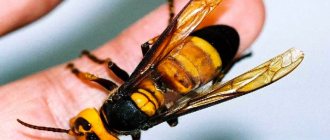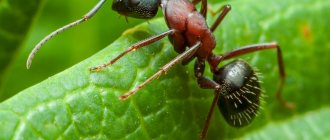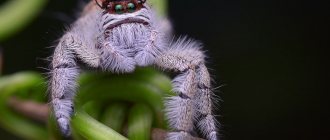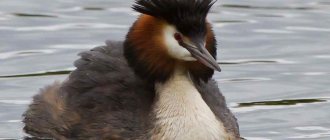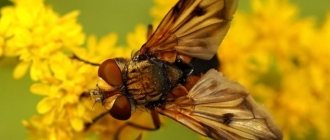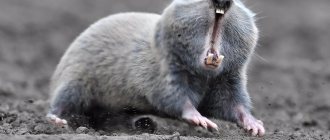- Wild animals
- >>
- Insects
We are surrounded by many interesting insects, among which the hornet .
These creatures have a very bright appearance, are quite large in size, and are excellent hunters of small pests. People don't hold hornets in high esteem. This is not surprising, because they can sting painfully, and their poison in large quantities can even lead to death. However, animals pose a great danger only in exceptional cases; a lethal dose can only be obtained with multiple bites. Otherwise, the hornet is a very interesting, useful insect. It's worth learning more about him!
What do hornets look like? (photo and description)
These representatives have different height parameters from 18 millimeters to 35. One of the largest is about 55 millimeters in length. In their structure, one can note a large head and a prominent crown. The compound eyes are located at the back. The color of the head is presented in a wide color palette - from black to yellow. They are also characterized by a striped abdomen, thin wings, strong jaws and large eyes.
Why is the hornet called that?
The roots of the word come from the Latin Vespa crabro (literally translated as “hornet wasp”). The common hornet is a species of large wasp that lives in Europe. It is larger in size than the common wasp, but smaller than the Asian hornet. In everyday life, hornets are called differently: “pirates”, “winged corsairs”. If we consider the meaning of the word hornet, then it means “evil man”, “obstinate”, Old Russian (srshen), Russian cer - Slavic (strashen), Polish (szerszen). In the 19th century, the genus Vespa was divided into two genera: hornets (vespa) and wasps (vespula), which means small wasp.
Area of residence
In the Northern Hemisphere, up to the 63rd parallel, the most common species is the common hornet. It can be found in Europe, North America, Kazakhstan, and Ukraine. In Russia, insects live over a vast territory from the European border to the Ural Mountains and Siberia. Even in the northern and eastern provinces of China they know what the European hornet looks like.
Interesting fact. Until the mid-19th century, hornet wasps were not found in North America. They were accidentally introduced by European sailors.
Where do hornets live?
The main part lives in the North of the globe. They can be observed in many parts of the planet. These insects have adapted well to warm Asian countries. European hornets live in agricultural areas, as well as in forests, thickets of groves, and large bushes. They like to build nests in toilets, on verandas, and in summer houses. They are also easy to find under stairs or in window openings. The vespin subfamily, living in the mountainous regions of Japan, is one of the most dangerous. In the Primorsky Territory of Russia you can find several species of these insects.
Video
And finally, we bring to your attention a film about our heroes, under the menacing title “Hornets - an empire of ruthless killers.”
Author: Pavel Chaika, editor-in-chief of Poznavaika magazine
When writing the article, I tried to make it as interesting, useful and high-quality as possible. I would be grateful for any feedback and constructive criticism in the form of comments on the article. You can also write your wish/question/suggestion to my email [email protected] or Facebook, with respect, the author.
Author page
What do hornets eat?
They love rotten trees and stumps. But their favorite food is rotting berries. They prefer foods that contain a large amount of sugars (tree sap).
They can feed on other insects (wasps, bees, grasshoppers). They kill them with their poison and then chew them with powerful jaws. Hornets attack apiaries, destroying entire colonies. They are attracted to the scent of honey bees. Some types of hornets look for dead insects and are even ready to feast on food waste (meat products, fish).
Nutrition
In terms of their feeding style, hornets are omnivorous insects, but they are still mostly vegetarians, preferring plant foods, especially if they are rich in sugar. They especially love overripe fruits: apples, pears, plums, they adore honey and nectar, which is why they often raid bee apiaries. If necessary, the hornet can turn into an excellent hunter, whose prey will be flies, grasshoppers, dragonflies, spiders,
butterflies, bees and even their closest relatives, wasps. Some particularly warlike species of tropical hornets can destroy up to 500 colonies of bees and wasps within their lifetime (not at all long)!
Interesting fact: representatives of the Vespa bicolor tropical hornet species living on Hainan Island sometimes attack orchids, mistaking them for bees by their smell.
But what is curious is that the prey killed by the hornet, which is thoroughly chewed into a suspension, is not used as food for the hornets themselves, but serves as a source of food for feeding the voracious larvae during their growth period. Sometimes hornets find dead insects for this purpose, which they also chew as food for their offspring.
Reproduction
As soon as the weather changes and the sun begins to warm up, the female hornet is actively looking for a place to hatch her eggs. She flies over large areas in search of shelter to start a family. As soon as it finds a convenient corner, it immediately begins building a nest. Each egg has its own sector. After a few days, a small individual will hatch from it. She chews the lid and gets out. Long before winter, the female breeds offspring, which will continue the work of the uterus.
After fertilization, the males die. Then the old queen dies, and after some time, the individuals that were not fertilized die. Fertilized hornets overwinter and then create their own nest. Only thanks to a well-coordinated organizational system in the hornet family, reproduction is successful. The division of duties (females, males and queen) allows feeding, building and raising offspring in a harmonious system.
Building a nest
An individual that has survived the cold season becomes the founder of the nest with the arrival of spring. Soon the female finds a safe place for herself high in the mountains or inside a tree. Then he arranges his place in the rooms where people live and in wooden outbuildings. Gnawing on woody species and crusty formations, insects build their houses from numerous steps. The wood goes through the stage of processing into a papyrus product. Such multi-level houses resemble products made from a thin napkin. You can see such structures in old trees, bird houses, barns. The color scheme of such designs can be varied. Brown stripes go with bright colors. Some of them look like an oval shape. But some are also round in shape. The size of such a structure is 700 by 400 mm.
Quite often, people compare the homes of hornets to a blotter nest, comparing the similarities with paper production. The main initial product for construction is thin tree cover and branches of young trees, well processed by hornets. Sticky saliva acts as a fastening material. Once applied to the house, it dries and hardens. The result is a rough, rough wrapper. The poor appearance of the structure is explained by the fact that the hornets build their houses from rotten wood. Some representatives of insects build their burrows with intricate labyrinths. They can be found deep in the ground or in forgotten animal holes. The depth of the hole can be about 60 meters.
Habitats
Hornets live in colonies in nests built in the form of several horizontal tiers of honeycombs. As a material for their home, they use a cardboard-like mass, which they make themselves by chewing wood fibers and moistening it with saliva. A nest can contain up to 7 rows of honeycombs, each row containing about 550 cells.
Hornets make their nests in hollow trees, in old birdhouses, under the roofs of houses, and in attics.
Inhabitants of steppe regions settle in animal burrows or underground.
Where do hornets spend the winter?
Hornets cannot tolerate extreme cold. But they carefully prepare for the winter. They set up their burrows on the property, at the dacha - wherever they can find shelter. How do insects manage to survive the winter and shelter from wet weather? Only the queens prepare for a long winter sleep. They play the role of leader in the family. For the female, the important point is to survive the winter and then lead her clan. It is also safe to hibernate. To do this, she has to stock up well on nutrients. Finding a good shelter can be considered a necessary condition for the survival of the uterus. Finding a safe place for the winter is a crucial moment in the life of the uterus.
To ensure ideal wintering conditions, you need to choose a quiet corner. Any option may be suitable except warm and cozy houses where people live. Since the warm temperature in the house can awaken the female earlier, and she will begin to build a nest. This scenario will lead to bad consequences. It will be difficult to find not only wood for the nest, but also food for the offspring. The uterus under such conditions is doomed to death. An important factor in favorable hibernation is stability, without sudden temperature changes. A large number of females die during harsh winters when there is little snow. They become easy prey for birds. As a result, most die.
Features of character and lifestyle
Photo: Hornet Red Book
Hornet wasps lead a social lifestyle. They gather in flocks and build nests. The number of one flock can reach hundreds of individuals. Hornet nests are distinguished by their special elegance and grace. These insects are one of the best builders. The founder of the nest is always the female that has survived the winter. With the onset of warmth, the female begins to search for a suitable place. Usually this place becomes an abandoned hollow in a tree, the attic of a residential building, or a crack in the rock.
The female begins building a nest from rotting wood and old bark. In this nest she establishes her colony. The first offspring of the female become worker wasps. They take over all responsibilities for construction, protecting the house, and feeding the offspring. Working hornets spend the whole day searching for food: nectar, plants, small insects. The lifestyle of hornets is predominantly diurnal.
These insects have a fairly high level of development. All representatives of the genus are able to distinguish each other's status. They do this by smell and other characteristics of adults.
The character of hornets is not warlike, they are not annoying. They will not climb into a jar of jam, and will not bother you with their presence near a feast with sweets and fruits. Hornets prefer to avoid the company of people, although they often build their nests in the attics of residential buildings. Despite this, hornet attacks on people are not that rare. And such a bite may not always go unnoticed. Severe allergic reactions occur. This is due to the high proportion of histamine in the venom of these insects.
How long do hornets live?
Hornets differ in appearance (body size) and perform different tasks and functions. In autumn, males begin the process of fertilization, after which they soon die. Working individuals have a short lifespan - no more than three weeks. The female lives the longest - about a year. Working females and males do not live long. They grow up at the end of summer, and in the fall (early September) most of the individuals die. The surviving insects survive only until the first cold weather. Males are needed by the family only for fertilization. After mating they live only a few days. The female is able to withstand the cold and live in hibernation for up to a year. In the second winter, its life cycle ends and it dies.
Life cycle of a queen
During her short life, the queen lays hundreds of eggs. The life cycle begins with eggs, which are laid by the female in late summer or early autumn. Males emerge from unfertilized eggs, and females from fertilized eggs. When they grow up, they leave the colony to mate, after which the males die, and the females look for a place to winter.
Just before wintering, the female begins to actively feed in order to stock up on nutrients and endure the winter more easily. Already in November, the hive becomes empty, the workers die, and the females are in the wintering place; the hive is not reused. Not everyone is able to survive the winter; with the arrival of spring, the surviving individuals climb out and begin to build new nests. They can overwinter in cracks, in the walls of buildings, under bark or in hollows.
The winter period is called diapause. At this time, metabolic processes slow down, due to which the nutrients accumulated in the spring are consumed very slowly. To transition into diapause, two factors are necessary, the first is that the air temperature drops sufficiently, the second is that the duration of daylight hours decreases.
Thanks to diapause, insects easily tolerate the negative effects of external factors, and their protective functions increase. But what this condition will not protect against is predators who don’t mind feasting on hornets. Since they often choose places such as tree bark and hollows for wintering, there is always a danger of becoming a victim of birds or mammals.
When spring comes and warm days come, they wake up and first of all start looking for food. During this period, their diet consists of small insects, but as soon as berries and fruits appear, their menu becomes more varied. The queen then surveys the area and selects the most suitable location to build a nest. They often choose trees, birdhouses, hollows, space under the roof of residential buildings, and even depressions in the ground for construction.
To build the first honeycomb, in which the first eggs will subsequently be laid, she chews the bark of trees, which serves as material. Alone, she arranges about 40-50 cells and then begins laying eggs. Females and males emerge from the clutch. Males are workers, and females can later become queens.
Types of hornets
There are several dozen popular species. Hornets are part of the wasp family. They have a lot in common, but have a number of distinctive features that set them apart from other individuals. There are 23 species of hornets. The most common types:
- Common (living in Europe): brown, body length 35mm. It is distinguished by two bright stripes on the lower part of the body. It is well known to Russian gardeners and beekeepers, but was recently brought to the USA and now lives there.
- Black hornet (Dybowski): stripes on the black back are yellow (predator color). The wings are brown. Length 35mm. Few people are familiar with this type of hornet. Listed in the Red Book. They live in the Amur region, Transbaikalia and Primorsky Krai.
- Giant Asian: its body length is 6 cm, has a large wingspan. It is distinguished by its bright head and striped back. lives mostly in Asian spaces. It is also found in the mountains of Sri Lanka, as well as in India and Taiwan. It has a large sting about 6mm. The bite is dangerous and contains a toxic substance. One of the largest in the world.
Some of the most dangerous hornets are Asian hornets, called “killer” hornets. - Japanese hornet (Japanese): a subspecies of the giant hornet called the "sparrow-bee" lives on Sakhalin. Large yellow head, large eyes, adjacent to them are 3 ocelli. The bite is painful and has dangerous consequences, as the venom contains toxins.
- Eastern: has the most elaborate coloring of all types. It is distinguished by a wide yellow stripe on its belly. Bright red with a crimson tint to the wings and body. One of the many species that tolerates heat well. Well adapted for living in deserts and steppes. Originally from North Africa.
- Philippine hornet: has a black color. Another name for the species is Lamentable. It is dangerous because it produces highly toxic poison. The bite is very unpleasant. The main habitat is the Philippine Islands.
Who will lose in battle?
As we learned above, the hornet is able to attack certain insects, knowing that it will win. But there are insects that act as aggressors towards it. So, the hornet has a rather complex relationship with spiders, let’s learn about them in more detail.
First of all, it is worth saying that a spider can act in these relationships both as a killer and as a victim, much depends on their species. If we talk about spiders that hunt victims without using webs, for example, jumpers, small tarantulas, haymakers, when they meet a hornet they will die, thanks to its powerful jaws.
The web of a cross spider is a completely different matter; for humans it is safe, non-toxic and not very large in size, but for a hornet such an encounter will most likely end in death.
Let's take a closer look at the relationship with the tarantula spider; in this case, the chances of winning are almost equal. The fact is that they have almost the same size, both rivals are quite strong, and both have poison, but in the tarantula it is many times stronger, so the one who first inflicts a fatal bite has a greater chance of winning.
Now let's look at our closest relatives, namely stray ants and road wasps. Despite the fact that hornets act as predators in this case, there is a high probability of ending up as a prey when meeting them. The wasp has a powerful weapon - deadly poison, but the ants defeat it due to their numbers; they never attack alone.
The hornet also has a biological enemy, a unique fungus that develops in its brain. Fungal spores enter the insect’s body through the respiratory tract or through the mouth, and begin to germinate in the head; the development of the fungus leads to the fact that the insect begins to constantly feel thirsty. The hornet begins to look for water, when the source is found, the mushroom causes paralysis. The victim freezes in one position and then dies.
The death of a hornet, no matter how strange it may sound, gives life to a new organism, albeit a completely ordinary one. The dead body becomes a place for the fungus to grow and a place from which new organisms spread.
The list of hornet enemies does not end there, because they are also found among vertebrates. Let's find out in more detail who is on this list:
- Bee-eater birds. Their favorite food is bees and wasps, and they know how to catch hornets in such a way that they cannot bite. Afterwards, they smash the insect against a stone and swallow it, so that it does not cause harm to health. Other birds can feed on hornets in the same way.
- Human. It is the hornet's largest and most dangerous enemy and can kill hornets in huge numbers without much effort.
- Small parasites. Other enemies are nematodes, mites, and parasites, which are very difficult to destroy.
Differences between a hornet and a wasp
These individuals are easily distinguished not only by size. The main difference from the wasp is its large, impressive jaws, unlike representatives of wasps. The coloring is slightly different. In the hornet it is more diverse. It is larger in size and has a hairy fluff. The hornet is distinguished by its movable whiskers and crown. There are similarities, but the wasp has a narrow waist.
How dangerous are hornets to humans?
Hornets can pose a danger to people in some cases. To protect themselves, the hornets gather very quickly; for this, the individual releases a special substance - an alarm signal. Other individuals can react to it and fly to the aid of a comrade and attack the offender en masse. Therefore, you should not touch the hornet in vain.
The mortality rate from hornet stings is very low, but the risk is still present. In addition, each subsequent sting will be worse tolerated by the body, because immunity to the poison is not developed, but on the contrary, the negative reaction intensifies.
Danger to humans - myth or reality?
The behavior of the common hornet differs significantly depending on the distance from the nest. During flights for food for themselves, the queen and larvae, they behave peacefully. But, when a real or imaginary danger to the nest appears, the hornets mercilessly sting everyone who falls into the zone of their aggression. There are always several individuals on duty near the house for protection. In the event of an attack, they give a special alarm signal that gathers the whole family.
How dangerous are hornets to humans? The strong venom of insects when bitten causes an attack of pain. Unpleasant sensations and swelling may persist for several days. The symptoms are similar for all victims, only the intensity of the manifestation differs.
Insects jealously defend their nest, but with careful approach, you can monitor the life of the colony. The main thing is to remember a few rules of behavior:
- do not make sudden movements;
- do not touch the nest with your hands or a stick;
- do not interfere with the flight of the hornets.
It is recommended to destroy the nests of the common hornet only if there is an increased danger in the neighborhood. For example, if it is located in a used room or next to an apiary. Predators are the worst enemies of bees and beekeepers. People with hypersensitivity to poison should get rid of the neighborhood, otherwise they will be in danger. In general, large wasps are peaceful neighbors, which will also help with the destruction of pests.
Hornet sting: harm of poison and consequences of toxic effects
The bite of this insect is more painful than a bite from a bee or wasp. It all depends on the individual body’s ability to tolerate pain. If a sting occurs, it is advisable to help the person as quickly as possible. Hornets have a needle with which they can pierce the human body repeatedly. Individuals from Asia are more poisonous than European ones. The bite is accompanied by sharp pain with severe swelling. May cause: severe pain and hemorrhage followed by suppuration.
Does the hornet bite or sting?
The hornet has powerful jaws. His bites are very deep. The wounds take almost a week to heal. When attacking a person, hornets use a sting that leaves scars in the form of dots, but they can also simply bite with their claws. The poison is dangerous because it is toxic and can poison the body. The bite is very painful and the consequences can be unpredictable. Elderly people, children and allergy sufferers are especially at risk. Swelling and inflammation can appear instantly after an insect attack, and suppuration is also possible. Signs of poisoning are characterized by nausea and severe dizziness.
Bites pose the greatest danger to those people who have an allergic reaction. They can worsen a person’s condition from several hours to 2-3 days. The bite is dangerous because the body of a person with allergies does not fight well against the effects of the poison. As a result, large swelling and difficulty breathing may occur. In some cases, people lose consciousness. The insect venom contains histamine, which most often causes a person to feel unwell, up to and including anaphylactic shock. Fatalities are caused by neglect of medical care and delayed first aid.
Fighting hornets in the house
Considering the danger of bites, the proximity of a hornet nest to people is undesirable. If there are uninvited neighbors under the roof of a house, in a barn or on a tree nearby, you need to get them out. It is useless to fight individual individuals - in order to destroy the queen and the entire colony, it is necessary to destroy the nest. This will help you do this:
- Chemicals. The plastic bag is treated from the inside with insecticides and placed on the nest. The top edges of the bag are glued with tape to the surface on which the nest is located, so that the hornets do not fly out. Effective means: Dichlorvos;
- Get;
- Raptor;
- Karbofos;
- Tetrix.
Sometimes, to combat hornets, traps made of plastic bottles with sweet liquid are used as bait. The insects fly into the bottle and can’t get out. But this method makes sense only with a small number of insects flying in from somewhere. The nest cannot be destroyed this way.
A hornet trap is a very simple but ineffective remedy.
You can also try traditional methods, they are less effective, but they are accessible and mostly safe for people and pets:
- red pepper pods are hung next to the nest;
- poison insects with boric acid, adding meat or sweets as bait, and placing poison near the nest;
- the hornets' home is doused with boiling water;
- all exits from the nest are filled with foam - the hornets will die inside from lack of water and food;
- you can also fill the nest with foam from a fire extinguisher;
- make a water trap by placing a bucket of water so that the entire nest is flooded;
- It is believed that planted mint, geranium, and lemon balm repel hornets.
What to do if bitten by a hornet?
Usually people have little idea what to do if they are bitten by an insect or do not have enough knowledge to provide first aid. The appearance of severe pain is not a sign that the human body is subject to destruction. You need to know that insect venom contains components that have a strong effect on nerve endings. Therefore, the pain shock can be pronounced. In a normal situation, it is quite difficult to predict the consequences of a bite; each person’s body reacts individually. For some, a bite can only cause pain and swelling, while for others it can end in disaster, including asphyxia, loss of consciousness and even death. If bitten, first aid must be provided immediately. Inaction is unacceptable!
- The first necessary condition that you need to remember is that there is no sting in the wound, only poison.
- Try to remove the poison by sucking it out.
- Treat the bite site with a solution of citric or acetic acid.
- Try washing with any soap solution.
- Treat the wound with an alcohol-containing solution or hydrogen peroxide.
- After this, you need to apply cold with wet sugar. This reduces the risk of poison spreading throughout the body.
- You should not drink alcohol after a bite. This will cause even more swelling and worsen the person’s condition. Bites to the neck and head area are very dangerous.
- From folk remedies, you can use the juices of plants such as dandelion, plantain or soda solution. Onion and garlic cloves are also suitable for treatment.
Signs of an allergic reaction from a bite:
- severe headaches;
- elevated temperature;
- cardiopalmus;
- hard breath;
- pain in the abdomen.
If you have these symptoms, you need to take painkillers in tablet form. This reduces the effect of histamine. You also need to drink a lot of water to reduce poisoning.
It must be remembered that if none of the methods help with a bite, and the condition begins to worsen, call a doctor immediately.
